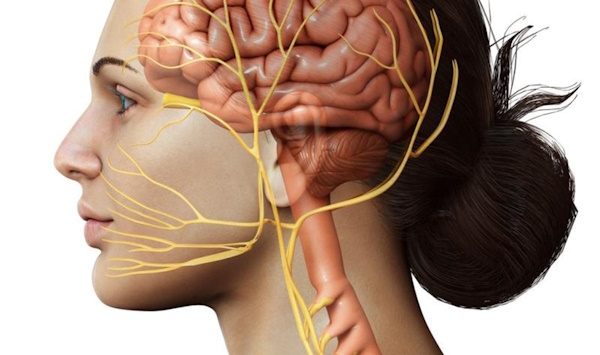Understanding the functions of the vagus nerve — and how you can stimulate it — can impact your mental and physical health for the better. Here’s what you need to know about how the largest nerve in your body affects IBS, anxiety, and the overall mind-body connection.
Stories about the vagus nerve have been making the social media rounds as everyone from influencers to doctors has discussed its variety of impacts on both physical and mental health. There are currently over 93 million videos on TikTok labeled with the hashtag #vagusnerve featuring ways to tap into, release, or simply understand the influence of the largest nerve in your body.
To give a quick biology lesson: The vagus nerve starts in the brain and then extends downward into the lungs, heart, and intestines, as well as into several muscles. It has a physical effect on swallowing, sweating, digestion, speech, and heart rate, among other bodily functions.
Notably, the vagus nerve is also highly integrated into the parasympathetic branch of the nervous system, which is a network of nerves that relaxes your body in response to danger or stress. (It’s associated with the “rest and digest” or “feed and breed” responses, whereas the sympathetic branch of the nervous system deals with the “fight or flight” response.)
According to Gabrielle Juliano-Villani, LCSW, an eye movement desensitization and reprocessing therapist who incorporates vagus nerve work with her clients, when the vagus nerve is activated, this triggers the “rest and digest” phase, which allows people to connect with others, be mindful, and feel calm. “I believe there is more awareness surrounding this now that trauma is becoming more mainstream and people are learning about the connection between physical health problems and our mental health,” she says.
The Health Benefits of Stimulating Your Vagus Nerve
Not only is the vagus having its social media moment, but recent research also backs up claims of this nerve’s health impacts. “The vagus nerve sends sensory information from the body to the brain, and it also controls vital systems in the body including heart rate, breathing rate, immune response, digestion, and bladder control, as well as many others,” licensed physical therapist and wellness coach Kelly Kessler says. “Needless to say, it plays a significant role in your overall well-being.”
Here are some of the influences the vagus nerve has on the body.
Mental Health
When it comes to mental wellness, the impact of the vagus is vast. “The vagus nerve affects mental health by decreasing stress, anxiety, and even symptoms of trauma,” Kessler says. “Stimulation of the vagus nerve also increases vagal tone, which is associated with decreased heart rate, decreased breathing rate, decreased blood pressure, and an overall calming effect.”
Heart Problems
Registered nurse and paramedic Krista Elkins says that people suffering cardiac events like supraventricular tachycardia, which is defined as having an irregularly fast or erratic heartbeat — sometimes even quadruple normal resting heart rate — can be helped with vagus nerve stimulation.
Inflammation and Inflammatory Diseases
While inflammation is the body’s natural way of responding to injury or disease, overactive inflammatory responses can lead to various diseases. For those with chronic inflammation, activating the vagus nerve can accelerate the body’s anti-inflammatory response, according to research, by calming the nervous system and lowering the body’s production of cytokines, which are proteins that control the growth and activity of other immune system cells. For people specifically suffering from rheumatoid arthritis, a common inflammatory disease, vagus nerve stimulation can actually reduce the disease’s severity.
Irritable Bowel Syndrome
The vagus nerve is involved in many of the important features of digestion, says Erica Golden, RDN, including the physical movement of food through the stomach and intestines, feelings of hunger and fullness, and even the slowing down of digestion when stress levels are high.
This gut-brain connection is strong, and research shows that people who suffer from digestive issues like irritable bowel syndrome also often have low vagal tone, which is a stress marker. Therefore, the anti-inflammatory effects of vagus nerve stimulation could also be helpful in restoring a balance between the digestive and neurological systems.
Long COVID
Preliminary research shows that those with vagus nerve dysfunction or disorders could be more at risk for long COVID, which affects 10 to 15 percent of people who contract and survive COVID-19. A pilot study indicated a link between people with long COVID symptoms — difficulty swallowing, voice problems, and tachycardia (abnormally high heart rate) — and vagus nerve dysfunction symptoms and irregularities of the nerve itself, as shown on an ultrasound. Though it’s too early to say that regular stimulation of the vagus nerve can prevent long COVID, this is definitely an interesting area of study.
How to Tap Into Your Vagus Nerve
Clearly, the vagus nerve can be integral to our overall health in many ways. Luckily, stimulation of the vagus is quite simple. Here are six expert-backed methods to try.
1. Vagus nerve massage
Gentle massage is a common method of vagus nerve stimulation. “Massage behind the ear since a branch of the vagus nerve actually travels near that area,” Kessler advises. “Additionally, gently tugging down on the ear also stimulates the vagus nerve.”
Psychiatrist Sam Zand, founder of the Anywhere Clinic, also suggests doing vagus nerve massage on the side of the neck where you can feel the pulse of your carotid artery pulse. “This can improve vagal tone and instantly calm down an increased heart rate and panicky feelings,” he syas. Press gently, circling the space under the angle of your jaw anytime you’re feeling anxious, he suggests. You can do this exercise for 5 to 10 minutes, but stop if you start feeling lightheaded or dizzy.
2. Vagus nerve tapping
Another common way to stimulate your vagus nerve is through tapping. Juliano-Villani suggests gently drumming your thymus point, or the midpoint of your chest. “This is known as the ‘happiness point,’” she says. “You can tap here with your pointer and index fingers for about 20 seconds, or longer if it feels good, while focusing on your breath. Notice what happens. For me, I get more energized and focused.”
3. Deep breathing
Juliano-Villani also suggests incorporating deep breathing into your daily routine to stay regulated. “Most of us are shallow breathers, so practice taking deep belly breaths and exhaling longer than you inhale,” she says. “If you suffer from anxiety and panic attacks, this is also important to integrate into your toolbox.”
4. Humming, singing, or gargling
Golden advises her patients to do one of these three things before eating a meal to get their bodies ready for digestion. “This can help reduce uncomfortable symptoms like bloating, stomach pain, cramping, and acid reflux after eating, and it can even help improve appetite in people struggling to eat enough,” she explains.
5. Progressive muscle relaxation
This biofeedback exercise involves tensing and then releasing each muscle group or area of the body for a few seconds and then moving to the next, starting at one end (like the face) and ending at the other (the feet). “It allows us to combine somatic mindfulness, relaxation breathing, and muscle tension relief to enhance the parasympathetic nervous drive,” Zand explains.
You can do this exercise once daily, though Zand says that ideally you would build up to doing it three times a day for optimal results.
6. Exercise
Finally, simple exercise can increase vagal nerve activity, Kessler says, particularly endurance and interval training. Any way that you’re able to move your body, though, can make a positive impact.
The Bottom Line
Understanding the many functions and impacts of your vagus nerve goes beyond simple biology. This incredible piece of internal hardware is always at your disposal.
“Having the tools to improve your overall well-being is not only empowering, but it also allows you to regulate your internal environment when the external environment is uncontrolled,” Kessler says.
While working with the vagus nerve isn’t a magic fix-all, knowing how to stimulate it puts you in the driver’s seat of your own body, allowing you to self-regulate when you’re feeling off center.





